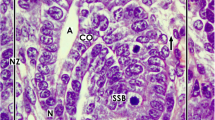Summary
The epithelial differentiation of the loop of Henle was investigated in the kidneys of Wistar rats between embryonic day 15 and postnatal day 30. Three stages can be distinguished in the development of the loop of Henle: (1) the primitive loop, (2) the immature loop and (3) the mature loop. The primitive loop of Henle is composed of thick undifferentiated tubule epithelium and is divided into a strongly basophilic proximal tubule anlage that stains dark in the semithin section, and a weakly basophilic, light-staining distal tubule anlage. The two anlages are separated by a cytologically sharp boundary located in the descending limb just before the bend of the loop. The immature loop of Henle is present when differentiation of the tubule epithelium begins. The shorter initial portion of the proximal tubule anlage develops into proximal straight tubule epithelium with brush border, brush border enzymes and lysosomal enzymes, while the longer, more distal portion of the proximal tubule anlage develops into thin undifferentiated epithelium that is a transitory feature of the immature loop stage. The primitive epithelium of the distal tubule anlage develops into distal straight tubule epithelium. The cytologically sharp boundary of the thin undifferentiated epithelium and distal tubule epithelium is located just before the bend of the loop. The loop of Henle matures as the thin undifferentiated epithelium in the medullary ray and outer stripe of the outer medulla becomes transformed into proximal straight tubule epithelium. At the point where this descending differentiation ends, the borderline of the inner and outer stripe of the outer medulla arises. The thin undifferentiated epithelium in the inner stripe and the inner medulla differentiates into the thin epithelium of the descending limb of Henle's loop. In the bend and ascending limb of long loops, the thick distal tubule epithelium is trans-formed by an ascending autophagous process into the thin epithelium of the ascending limb of Henle. The termination of this process marks the borderline between the inner and outer medulla. The thin descending and thin ascending limb of Henle arise from 2 different anlages; between them lies the histogenetic boundary of the proximal and distal renal tubule.
Similar content being viewed by others
References
Bargmann W (1978) Handbuch der mikroskopischen Anatomie des Menschen. Bd VII/5 Niere und ableitende Harnwege, p 444. Springer, Berlin Heidelberg New York
Berliner RW (1976) The concentrating mechanism in the renal medulla. Kid Int 9:214–222
Dietrich HJ, Kriz W (1969) Zum Problem der Fixierung des Nierenmarks. Licht- und elektronenmikroskopische Untersuchungen an der Außenzone der Rattenniere. Acta Anat 74:267–289
Dieterich HJ, Barrett JM, Kriz W, Bülhoff JP (1975) The ultrastructure of the thin loop limbs of the mouse kidney. Anat Embryol 147:1–18
Eränkö O, Lehto E (1954) Distribution of acid and alkaline phosphatase in human metanephros. Acta Anat 22:277–288
Hamburger O (1890) Über die Entwicklung der Säugethierniere. Arch Anat Physiol Suppl p 15–51
Huber GC (1905) On the development and shape of human uriniferous tubules of certain higher mammals. Am J Anat Suppl 4:1–98
Kaissling B, Kriz W (1979) Structural analysis of the rabbit kidney. Adv Anat Embryol Cell Biol 56:1–123
Karnovsky MJ (1965) A formaldehyde-glutaraldehyde fixative of high osmolality for use in electron microscopy. J Cell Biol 27:137A-138A
Koepsell H, Kriz W, Schnermann J (1972) Pattern of luminal diameter changes along the descending and ascending thin limbs of the loop of Henle in the inner medullary zone of the rat kidney. Z Anat Entwickl.-Gesch 138:321–328
Kugler P (1981) Localization of aminopeptidase A (angiotensinase A) in the rat and mouse kidney. Histochemistry 72:269–278
Larsson L (1975) Effects of different fixatives on the ultrastructure of the developing proximal tubule in the rat kidney. J Ultrastruct Res 51:140–151
Larsson L, Maunsbach AB (1975) Differentiation of the vacuolar apparatus in cells of the developing proximal tubule in the rat kidney. J Ultrastruct Res 53:254–270
Lojda Z, Gossrau R, Schiebler TH (1979) Enzyme histochemistry. Springer, Berlin Heidelberg New York p 339
Majack RA, Paul WK, Barrett JM (1979) The ultrastructural localization of membrane ATPase in rat thin limbs of the loop of Henle. Histochemistry 63:23–33
Mayor HD, Hampton JC, Rosario B (1961) A simple method for removing the resin from epoxy-embedded tissue. J Cell Biol 9:909–910
Mühlenfeld WE (1969) Über die Entwicklung und Chemodifferenzierung der Rattenniere unter besonderer Berücksichtigung der Geschlechtsunterschiede. Histochemie 18:97–131
Nagle RB, Altschuler EM, Dobyan D, Dong S, Bulger RE (1981) The ultrastructure of the thin limbs of Henle in kidneys of the desert heteromyid (Perognathus penicillatus). Am J Anat 161:33–47
Neiss WF, Klehn KL (1981) The postnatal development of the rat kidney, with special reference to the chemodifferentiation of the proximal tubule. Histochemistry 73:251–268
Oliver J (1968) Nephrons and kidneys. Harper & Row, New York Evanston London p 117
Osathanondh V, Potter EL (1966) Development of human kidney as shown by microdissection. IV. Development of tubular portions of nephrons. Arch Pathol. 82:391–402
Peter K (1927) Üntersuchungen über Bau und Entwicklung der Niere. V. Die Entwicklung der menschlichen Niere nach Isolationspräparaten. VI. Der Ausbau der Nierensubstanz. Fischer, Jena Vol. 2:522–647
Ricciarelli G (1970) Morphologische Untersuchungen zur postnatalen Entwicklung der Rattenniere. Med Diss, Münster
Richardson KC, Jarett L, Finke EH (1960) Embedding in epoxy resins for ultrathin sectioning in electron microscopy. Stain Technol 35:313–323
Schaeverbeke J, Cheignon M (1980) Differentiation of glomerular filter and tubular reabsorption apparatus during foetal development of the rat kidney. J Embryol Exp Morphol 58:157–175
Schiller A, Taugner R, Kriz W (1980) The thin limbs of Henle's loop in the rabbit. Cell Tissue Res 207:249–265
Schwartz MM, Venkatachalam MA (1974) Structural differences in thin limbs of Henle: Physiological implications. Kid Int 6:193–208
Stoerk O (1904) Beitrag zur Kenntnis des Aufbaus der menschlichen Niere. Anat Hefte 23:283–329
Author information
Authors and Affiliations
Additional information
Supported by the Deutsche Forschungsgemeinschaft (SFB 105)
Rights and permissions
About this article
Cite this article
Neiss, W.F. Histogenesis of the loop of Henle in the rat kidney. Anat Embryol 164, 315–330 (1982). https://doi.org/10.1007/BF00315754
Accepted:
Issue Date:
DOI: https://doi.org/10.1007/BF00315754




